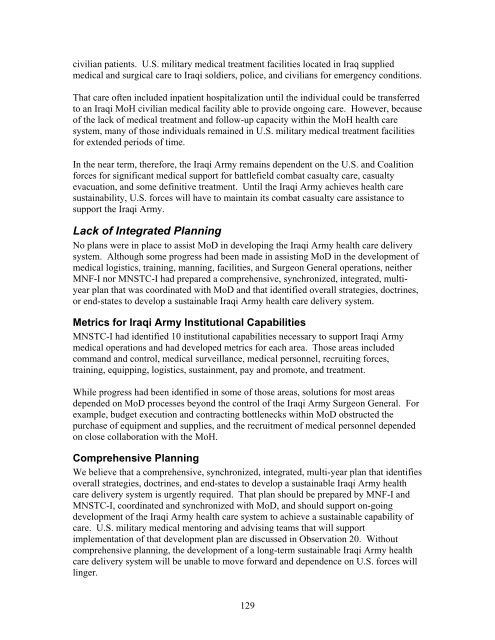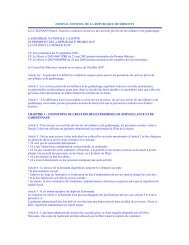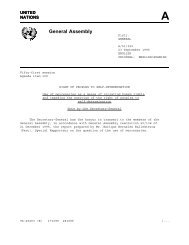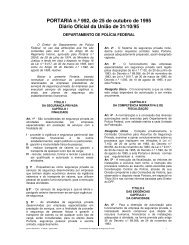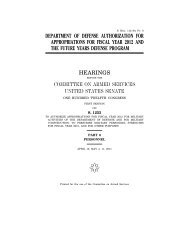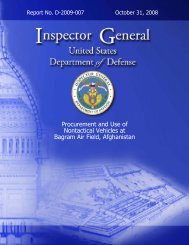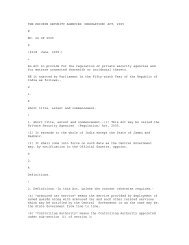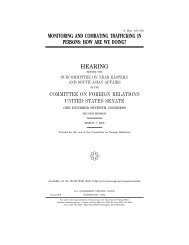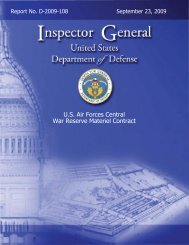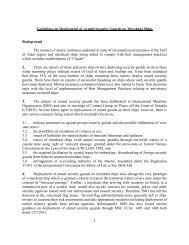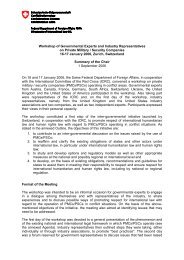Security Assistance; and Logistics - Federation of American Scientists
Security Assistance; and Logistics - Federation of American Scientists
Security Assistance; and Logistics - Federation of American Scientists
You also want an ePaper? Increase the reach of your titles
YUMPU automatically turns print PDFs into web optimized ePapers that Google loves.
civilian patients. U.S. military medical treatment facilities located in Iraq suppliedmedical <strong>and</strong> surgical care to Iraqi soldiers, police, <strong>and</strong> civilians for emergency conditions.That care <strong>of</strong>ten included inpatient hospitalization until the individual could be transferredto an Iraqi MoH civilian medical facility able to provide ongoing care. However, because<strong>of</strong> the lack <strong>of</strong> medical treatment <strong>and</strong> follow-up capacity within the MoH health caresystem, many <strong>of</strong> those individuals remained in U.S. military medical treatment facilitiesfor extended periods <strong>of</strong> time.In the near term, therefore, the Iraqi Army remains dependent on the U.S. <strong>and</strong> Coalitionforces for significant medical support for battlefield combat casualty care, casualtyevacuation, <strong>and</strong> some definitive treatment. Until the Iraqi Army achieves health caresustainability, U.S. forces will have to maintain its combat casualty care assistance tosupport the Iraqi Army.Lack <strong>of</strong> Integrated PlanningNo plans were in place to assist MoD in developing the Iraqi Army health care deliverysystem. Although some progress had been made in assisting MoD in the development <strong>of</strong>medical logistics, training, manning, facilities, <strong>and</strong> Surgeon General operations, neitherMNF-I nor MNSTC-I had prepared a comprehensive, synchronized, integrated, multiyearplan that was coordinated with MoD <strong>and</strong> that identified overall strategies, doctrines,or end-states to develop a sustainable Iraqi Army health care delivery system.Metrics for Iraqi Army Institutional CapabilitiesMNSTC-I had identified 10 institutional capabilities necessary to support Iraqi Armymedical operations <strong>and</strong> had developed metrics for each area. Those areas includedcomm<strong>and</strong> <strong>and</strong> control, medical surveillance, medical personnel, recruiting forces,training, equipping, logistics, sustainment, pay <strong>and</strong> promote, <strong>and</strong> treatment.While progress had been identified in some <strong>of</strong> those areas, solutions for most areasdepended on MoD processes beyond the control <strong>of</strong> the Iraqi Army Surgeon General. Forexample, budget execution <strong>and</strong> contracting bottlenecks within MoD obstructed thepurchase <strong>of</strong> equipment <strong>and</strong> supplies, <strong>and</strong> the recruitment <strong>of</strong> medical personnel dependedon close collaboration with the MoH.Comprehensive PlanningWe believe that a comprehensive, synchronized, integrated, multi-year plan that identifiesoverall strategies, doctrines, <strong>and</strong> end-states to develop a sustainable Iraqi Army healthcare delivery system is urgently required. That plan should be prepared by MNF-I <strong>and</strong>MNSTC-I, coordinated <strong>and</strong> synchronized with MoD, <strong>and</strong> should support on-goingdevelopment <strong>of</strong> the Iraqi Army health care system to achieve a sustainable capability <strong>of</strong>care. U.S. military medical mentoring <strong>and</strong> advising teams that will supportimplementation <strong>of</strong> that development plan are discussed in Observation 20. Withoutcomprehensive planning, the development <strong>of</strong> a long-term sustainable Iraqi Army healthcare delivery system will be unable to move forward <strong>and</strong> dependence on U.S. forces willlinger.129


